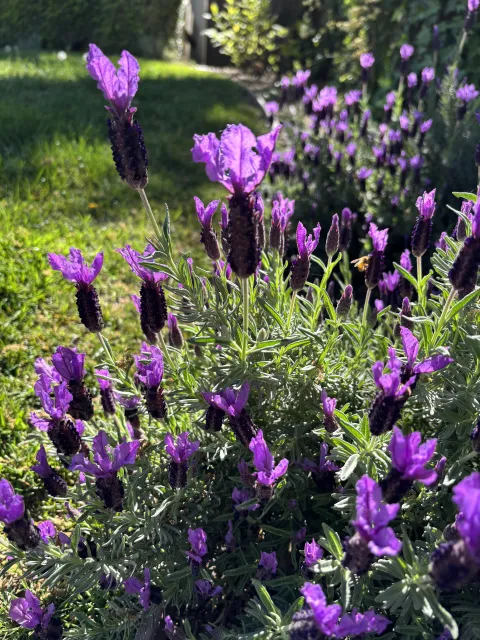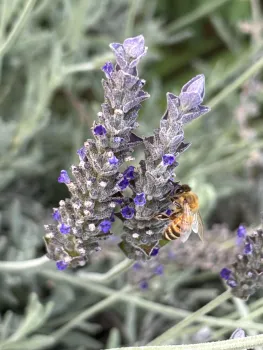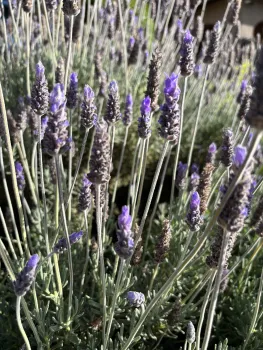Article by Joy Humphrey -

Before I developed an interest in gardening, I thought there was only one type of lavender—just, you know, lavender—and that it made a really nice scent for hand lotion. After I became a gardener, I discovered there is a whole world of lavender out there in numerous shapes, sizes, and colors. Lavender is a gardener’s dream, one with few requirements and an abundance of rewards. Yes, it does make a nicely scented hand lotion, but there is so much more this low maintenance plant has to offer.
A member of the mint family (Lamiaceae), Lavender (Lavandula) originated in Mediterranean climates, so it is an excellent drought-tolerant perennial for Zone 9b gardens where summers are hot and dry, and winters are cool and wet. It has a long blooming season, and depending on the variety, you can have blooms from early spring through late fall. Pollinators flock to the flowers, but the strong scent repels pests. Lavender is a low-maintenance plant with moderate water needs, no fertilizer schedule, and minimal pruning chores. Depending on the variety, it can work as a hedge or a border, it can be happy in a container, and it looks good even when it is not in bloom.
Not all lavenders are created equal, and some varieties are more appropriate than others depending upon their intended use. Listed below are some of the main species you are likely to find in your local garden center, along with their main characteristics.
English Lavender (Lavendula angustifolia)
If you are interested in growing lavender for use in the kitchen, this is the type you want to choose. The flowers are delicious in sweet and savory dishes, herb mixes, and beverages. It is also a good choice for perfumes and sachets. A very hardy species, it grows on the smaller size to about two feet high depending on the variety. It blooms in early summer and can bloom again in late summer to fall. A popular variety is ‘Royal Velvet’, which is known for its sweet fragrance and mild flavor. English lavender also makes an excellent dried flower since the blooms retain their color.
Spanish Lavender (Lavendula stoechas)
This is the unusual-looking lavender with blooms that have “bunny ear” bracts sprouting from the top of the squat flower spike. It is one of the earliest bloomers, beginning in early spring and continuing into summer. It may have a second flush of blooms if the plant is lightly trimmed after the first bloom cycle. It is fairly compact, growing from one-and-a-half to three feet high, and it is especially heat and drought-tolerant. Spanish lavender can be found in a range of colors from white to dark purple. A particularly good variety for Zone 9b is the reddish-purple ‘Otto Quast’, a UC Davis Arboretum All-Star. Take note that Spanish lavender is not recommended for culinary uses due to its high camphor content which gives it a stronger, sharper scent and a bitter taste.

French Lavender (Lavendula dentata)
This species is known for its striking toothed leaf structure, which is more fragrant than the flowers. It blooms spring to summer and is on the larger size, growing three to four feet tall and four to six feet wide. Like Spanish lavender, this species has bracts at the top of the flowering spike, but they are not as pronounced. French lavender’s strong fragrance is more camphor-like so it is more often grown for essential oils rather than for culinary uses.
Lavandin (Lavendula x intermedia)
Lavandin, also known as Hedge Lavender, is a hybrid of English lavender and Portuguese lavender (Lavendula latifolia). The flower spikes appear in spaced segments on branching stems, and it blooms from mid to late summer. Larger than English lavender, this hybrid grows around three feet high and wide. This is a very fragrant species that is most often used for body and home products rather than cooking. ‘Grosso’ is one of the most fragrant varieties, and it is often grown on commercial farms for use in essential oils. Lavandin varieties make excellent dried flowers.
Goodwin Creek lavender (Lavendula x ginginsii ‘Goodwin Creek Grey’)
This Arboretum All Star hybrid is of note since it does very well in our area. It is particularly heat-tolerant and grows from two-and-a-half to three feet high and three to four feet wide. It blooms from spring to late fall and has toothed leaves similar to French lavender.
There are numerous cultivars within all these species, with various sizes and color attributes that are worth exploring for your particular garden. But no matter what variety of lavender you choose, the growing requirements are generally the same.
Location
Lavender is a sun-loving plant, and it grows best with six to eight hours of sun a day. That said, I have had success growing Spanish lavender in four hours of sun a day. Don’t hesitate to experiment if you have less than ideal conditions; your plant might not bloom as profusely with less sun, but the results might be good enough for your own garden.
Lavender is also heat-tolerant, and many varieties can handle radiant heat. It’s a good choice for borders along sidewalks, against a wall, or in pots on a patio. Some varieties are more heat tolerant than others, so for hotter locations, Goodwin Creek lavender or Spanish lavender are better choices.
Soil
Lavender is not picky about the soil it grows in with the exception of heavy, moisture-retaining clay soil, since it needs good drainage. If the latter is an issue in your garden, amend with organic compost and consider planting on a mound to help with drainage. Another option is to plant your lavender in a raised bed or a container where you will have control over the soil.
Planting
Plant lavender in the spring after the risk of hard frost has passed. Alternatively, it can be planted in the fall as long as the roots have enough time to become established before the first frost. Dig a hole so that the crown of the root ball is level with the soil surface and space the plants so that they get good air circulation. If you are planting your lavender with other types of plants, make sure they are drought-tolerant varieties as well.
Fertilizing

Lavender can grow in nutrient-poor soil, so there is no need to supplement with fertilizer. In fact, regular fertilizing can inhibit blooming and sometimes cause the plant to break apart in the center. Only amend the soil if you are planting in clay, as noted above. If your plant is particularly slow-growing, use a 10-10-10 fertilizer at the time of planting to give it a good start. But do not put your lavender on a regular fertilizer schedule.
Water
The key to growing lavender successfully is to make sure it doesn’t get too much water, which can result in root and crown rot. As drought-tolerant plants, they like well-drained soil. Let the first three to four inches of soil dry out before watering. Water needs for newly planted lavender will be slightly more in the first year as the roots get established. Opt for drip irrigation and avoid overhead watering, as this can damage the plant.
Pruning
To encourage repeat blooming, lightly trim lavender after each bloom cycle. Give plants a more serious prune at the end of the season cutting them back by about one third if you have Spanish or French lavenders. English lavender can handle a more severe prune so cut back by one half. However, with any variety, do not cut into the woody part of the plant since it will not produce new growth from woody stems. Prune only the supple new growth and shape into a tidy mound.
For more information and inspiration, consider visiting a lavender farm for an immersive experience. Yolo County has a number of lavender farms that are open to the public. Some offer tours, workshops, lavender picking, picnic spots, and gift shops. An online search for “lavender farms in Yolo County” will provide you with a list to peruse for the specific activities or lavender varieties that pique your interest.
Photos by Joy Humphrey

